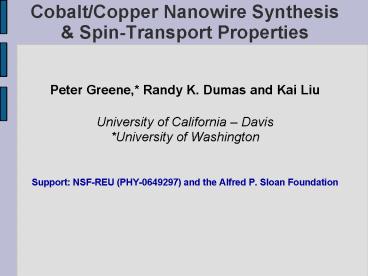CobaltCopper Nanowire Synthesis - PowerPoint PPT Presentation
1 / 12
Title:
CobaltCopper Nanowire Synthesis
Description:
Multilayered nanowires as model system to study nanomagnetism & spintronics ... the magnetic layers to point antiparallel or randomly causing a high resistance ... – PowerPoint PPT presentation
Number of Views:58
Avg rating:3.0/5.0
Title: CobaltCopper Nanowire Synthesis
1
Cobalt/Copper Nanowire Synthesis Spin-Transport
Properties
- Peter Greene, Randy K. Dumas and Kai Liu
- University of California Davis
- University of Washington
- Support NSF-REU (PHY-0649297) and the Alfred P.
Sloan Foundation
2
Overview
- Motivation
- Sample Fabrication
- Measurement Techniques
- Results
3
Motivations and Goal
- Motivations
- Multilayered nanowires as model system to study
nanomagnetism spintronics - Magnetization reversal mechanisms of nanodiscs
fascinating - Vortex state vs. single domain
- Spin-dependent electrical transport as
manifestation of magnetic configurations - Applications Ultrahigh density magnetic storage
novel spintronic devices - Goal
- Probe nanoscale magnetic configuration using
giant magnetoresistance
4
Nanowire Fabrication
5
Electrodeposition
- Electrolyte contains Co2 and Cu2 ions
- Concentration of Co is 80 times that of Cu
- Integrate current to estimate number of atoms
deposited and obtain desired thickness
6
Magnetoresistance (MR)
- Modified VSM operating system to make resistance
versus applied field measurements - Capability to make both AC and DC resistance
measurements - Automation makes resistance FORCs feasible
- Will R-H and M-H FORCs yield correlation between
magnetic configuration MR?
7
Giant Magnetoresistance
- Current flowing perpendicular to spaced magnetic
planes can be decomposed into two oppositely spin
polarized currents. - The current with electron spin parallel to the
magnetization of a plane is preferred and thus is
less likely to scatter. - Low fields allow the magnetic layers to point
antiparallel or randomly causing a high
resistance state as neither spin polarization is
preferred. - High fields align all of the magnetic layers
causing one spin channel to be shunted throughout
the wire.
High Resistance Low Field
Low Resistance High Field
2007 Nobel Prize in Physics M. N. Baibich, J. M.
Broto, A. Fert, F. N. V. Dau, F. Petroff, P.
Eitenne, G. Creuzet, A. Friederich, and J.
Chazelas, Phys. Rev. Lett. 61, 2472 (1988). G.
Binasch, P. Grunberg, F. Saurenbach, and W. Zinn,
Phys. Rev. B 39, 4828 (1989).
8
Single Domain vs. Vortex State
9
Reversal Mechanisms
Single Domain
Vortex State
M-H FORCs show information about the domain
reversal process. Perhaps R-H FORCs will show
similar information with smaller sample
sizes. How does the two current model of GMR
apply to vortex states?
R. K. Dumas, et al, Phys. Rev. B, 75, 134405
(2007) Appl. Phys. Lett. 91, Nov. 12, 2007.
K. Liu, et al, Appl. Phys. Lett., 81, 4434 (2002).
10
Results Single Domain GMR
- Fabricated 50- 200nm diameter nanowires with Cu
and Co thickness 1- 60nm - Obtained 7 room temperature CPP-GMR
- Strong evidence of single domain reversal
50nm diameter Co(5nm)/Cu(8nm)400
11
Results Alternate GMR Signals
200nm diameter Co(50nm)/Cu(10nm)150 nanowires
- Evidence of vortex state reversal if disks are
isolated - Low field anisotropic MR
- Saturation resistances are not equal (?)
- Magnetostatic interactions within the wires are
strong
12
Summary
- Synthesized arrays of Co/Cu multilayered
nanowires - Measured magnetization reversal signatures and
magneto-transport properties - 50nm diameter Co(5nm)/Cu(8nm)400 nanowires
- Single-domain reversal
- 7 room temperature CPP-GMR
- 200nm diameter Co(50nm)/Cu(10nm)150 nanowires
- Reversal via vortex state in Co nanodiscs with
similar dimensions - Fine features in MR at low field anisotropic MR
due to vortex structures































